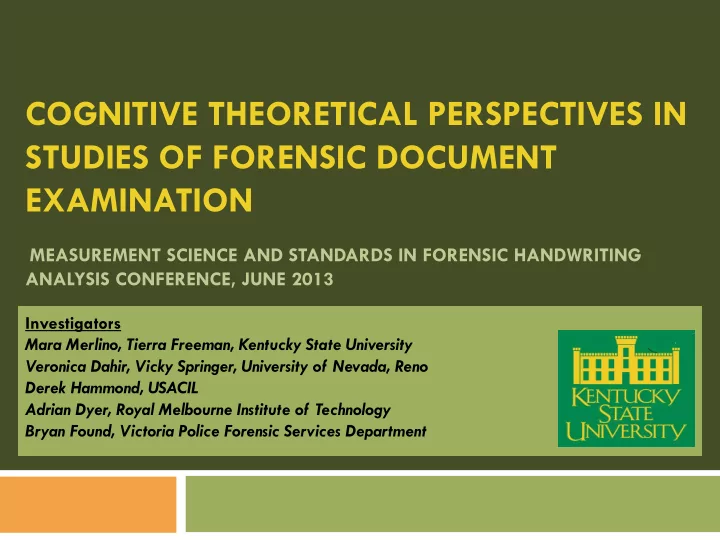

COGNITIVE THEORETICAL PERSPECTIVES IN STUDIES OF FORENSIC DOCUMENT EXAMINATION MEASUREMENT SCIENCE AND STANDARDS IN FORENSIC HANDWRITING ANALYSIS CONFERENCE, JUNE 2013 Investigators Mara Merlino, Tierra Freeman, Kentucky State University Veronica Dahir, Vicky Springer, University of Nevada, Reno Derek Hammond, USACIL Adrian Dyer, Royal Melbourne Institute of Technology Bryan Found, Victoria Police Forensic Services Department
Acknowledgements This project was supported by Award No. 2010-DN-BX-K271, awarded by the National Institute of Justice, Office of Justice Programs, U.S. Department of Justice. The opinions, findings, and conclusions or recommendations expressed in this publication/program/exhibition are those of the author(s) and do not necessarily reflect those of the Department of Justice. Thanks to our Kentucky State University undergraduate research assistants Cierra Alexander, Kara Francis, Kara Floyd, Nick Williams, Laurice Jackson, Savada Smothers, Melissa Pickett, and Inna Malyuk. Special thanks to our colleagues from the U.S. and Canada for their invaluable assistance with the planning and pilot stages of our project, and to those FDEs who have given their time and expertise as project participants.
The Comparison Process What FDEs do (decision process) If Q is suitable for comparison, then Evaluate Compare Determine significance Evaluate quantity Conclusion But HOW do they do it?
Answering the “HOW” Question Attention Focus and filtering • What do we attend to? Attentional and foveal focus Why do we attend to it? Stimulus-driven Goal-directed
Examine these signatures… What questions come to your mind?
Top-Down vs. Bottom-Up Processing Top Down Processing Bottom-Up Processing “Large chunk" processing “Small chunk" processing LARGER CONCEPT FINER DETAILS FINER DETAILS LARGER CONCEPT
You Make the Call How much information does an examiner need to make an accurate call? Tachistoscope view of a signature: 1. Look at the fixation cross. 2. After 3s the slide will automatically change to a signature. 3. Don’t blink —you’ll miss it!
Process Opinion Would you say that this signature is genuine, or simulated? On a scale of 1 (not at all confident) to 4 (extremely confident), how confident would you say you are in this decision? Not at all confident Somewhat confident Moderately confident Extremely confident
Process Opinion Would you say that this signature is genuine, or simulated? On a scale of 1 (not at all confident) to 4 (extremely confident), how confident would you say you are in this decision? Not at all confident Somewhat confident Moderately confident Extremely confident
Interpreting Eye-Tracking Data Identifying diagnostic information using extended view data Unfiltered (raw) data Filtered data Heat maps Areas of interest (AOI)
Signature 1 Raw Data Fixations: FDE1=1,200; FDE2=683; FDE3=1,196 Raw data without the fixation filter demonstrates all visual activity
Signature 2 Raw Data Fixations: FDE1=7,361; FDE2= 3,632; FDE3=1,706 Some activity is irrelevant, data must be refined Velocity threshold = 50 pixels Duration threshold = 100ms
Filtered Signature 1 Gaze Plots Total Fixations: FDE1=60; FDE2=22; FDE3=43 Fixation Duration: FDE1=30.16s; FDE2=29.24s; FDE3=31.84s
Filtered Signature 2 Gaze Plots Total Fixations: FDE1=292; FDE2=70; FDE3=64 Fixation Duration: FDE1=132s; FDE2=74s; FDE3=44s
Finding the Diagnostic Hot Spots Unfiltered heat map Areas of Interest (AOI) Filtered heat map
Overall Call Accuracy Overall Accuracy by View and Orientation 700 accuracy= 600 1161/1647= 500 Accuracy 400 70% 300 Accuracy 200 slightly higher 100 for RSU than 0 Yes No Yes No Yes No USD Tscope Extended Total Up 284 127 311 95 595 222 Down 271 137 295 117 566 254
Call Accuracy by View Duration All Trials (N=1638 calls) 1162 Accurate (70.9%); 476 Inaccurate (29.1%) κ = .416 (moderate agreement) Accuracy by Signature View Accuracy by Signature View Trial 1 Trial 2 Correct Incorrect Correct Incorrect 41 41 40 39 38 38 38 38 38 36 36 36 34 33 32 28 28 26 24 22 19 17 15 13 13 9 8 7 5 5 5 3 3 2 2 2 2 1 1 0 1.1 1.2 2.1 2.2 3.1 3.2 4.1 4.2 5.1 5.2 1.1 1.2 2.1 2.2 3.1 3.2 4.1 4.2 5.1 5.2
Call Accuracy by View Duration Extended View (N=818) Tscope View (N=819) 606 Accurate (74.1%) 555 Accurate (67.8%) 212 Inaccurate (25.9%) 264 Inaccurate (32.2%) κ = .480 (mod agreement) κ = .352 (fair agreement) Accuracy by Signature View Accuracy by Signature View Trial 3 Trial 4 Correct Incorrect Series1 Series2 41 41 39 38 38 38 37 35 34 30 27 27 27 24 24 24 24 23 22 22 19 19 18 17 17 17 17 14 14 14 11 7 6 4 3 3 3 2 0 0 1.1 1.2 2.1 2.2 3.1 3.2 4.1 4.2 5.1 5.2 1.1 1.2 2.1 2.2 3.1 3.2 4.1 4.2 5.1 5.2
Education and Training Implications Practice, talent, and skill development Some talent + much training = expertise IF practice is deliberate Deliberate practice Motivated learner Performance feedback Performance monitoring Elimination of incorrect response Implications of knowledge about expertise for teaching Skill acquisition training Importance of problem decomposition Componential analyses Mastery learning
Future Directions Expertise Stages of development Skill organization Practice vs. talent Education and training The Comparison Process Characteristics Attention, perception, the comparison process, decision making Judgment Probability- vs. frequency-based judgment Scale properties
Contact Information PI: Mara L. Merlino, Ph.D. Department of Behavioral and Social Sciences, Kentucky State University 400 East Main Street, Frankfort, KY 40601 (502) 597-5053 mara.merlino@kysu.edu Co-PI: Tierra M. Freeman, Ph.D. Department of Behavioral and Social Sciences, Kentucky State University 400 East Main Street ,Frankfort, KY 40601 (502) 597-5932 tierra.freeman@kysu.edu PI: Veronica Blas Dahir, Ph.D. Associate Director, Center for Research Design and Analysis Mail Stop 088 ,University of Nevada, Reno , Reno, NV 89557 (775) 784-1056 (direct line) veronicad@crda.unr.edu Co-PI: Victoria A. Springer, M.A . Center for Research Design and Analysis Mail Stop 088, University of Nevada, Reno, Reno, NV 89557 (775) 247-7449 vspringer@crda.unr.edu
Recommend
More recommend